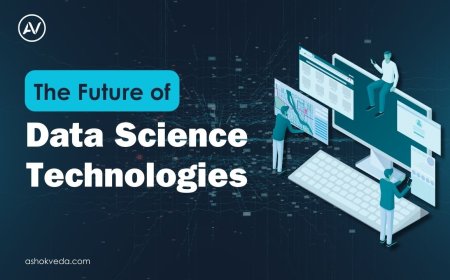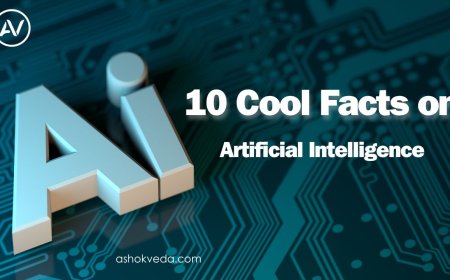Top AI Models for Predictive Analytics
Learn the top AI models used in predictive analytics, including neural networks, decision trees, and more. Learn how these models drive data insights.

If you want to learn how Artificial Intelligence might help predict future trends and results, we will look at several AI models and how they play an important role in predictive analytics. Whether you're an experienced Data Scientist or simply interested in the magic behind these models let's experience the field of AI Models for Predictive Analytics together! We'll go over how these models work, their applications, and much more.
What Are AI Models?
AI Models are the foundation of predictive analytics. These models use Artificial Intelligence, Machine Learning, and Deep Learning techniques to analyze data and make predictions. By training on historical data, these models can identify patterns and trends, helping businesses make informed decisions. There are several types of AI Models each suited for different tasks and data types.
Popular AI Models for Predictive Analytics
-
Linear Regression
Linear Regression is one of the simplest and most widely used AI Models. It predicts a target variable based on one or more predictor variables. It's commonly used in finance, healthcare, and marketing to forecast trends and outcomes.
-
Decision Trees
Decision Trees are intuitive and easy-to-understand AI Models. They split data into branches to make decisions based on certain criteria. They're used in various fields, including finance and healthcare, to predict outcomes based on historical data.
-
Random Forest
Random Forest is an ensemble learning method that combines multiple decision trees to improve prediction accuracy. It's particularly useful for classification and regression tasks in AI Applications such as fraud detection and risk assessment.
-
Neural Networks
Neural Networks mimic the human brain's structure and function. They're powerful AI Models capable of handling complex patterns and large datasets. Neural Networks are used in image and speech recognition, and Natural Language Processing (NLP).
-
Support Vector Machines (SVM)
SVM is a robust and versatile AI Model used for classification and regression tasks. It's effective in high-dimensional spaces and is commonly used in text and image classification.
How AI Models Work in Predictive Analytics
AI Models use various algorithms and statistical methods to analyze past data and make predictions.
-
Data Collection: Gathering relevant data from various sources.
-
Data Preprocessing: Cleaning and preparing the data for analysis.
-
Model Selection: Choosing the appropriate AI Model based on the problem and data type.
-
Training the Model: Feeding historical data into the model to learn patterns.
-
Testing the Model: Assessing the model's accuracy using test data.
-
Making Predictions: Using the trained model to predict future outcomes.
Applications of AI Models in Predictive Analytics
AI Models have a wide range of applications across various industries:
-
AI in Healthcare: Predictive analytics helps in diagnosing diseases, predicting patient outcomes, and managing healthcare resources efficiently.
-
AI in Finance: AI Models are used for risk assessment, fraud detection, and stock market predictions.
-
AI in Education: Predictive analytics can identify students at risk of dropping out and customize personalized learning experiences.
-
AI in Retail: Businesses use predictive analytics to forecast demand, manage inventory, and personalize marketing campaigns.
-
AI in Manufacturing: Predictive maintenance models help in predicting equipment failures and optimizing maintenance schedules.
Benefits of Using AI Models for Predictive Analytics
-
Improved Accuracy: AI Models can analyze large volumes of data and identify patterns that might be missed by traditional methods.
-
Cost Savings: By predicting future trends, businesses can optimize resources and reduce operational costs.
-
Better Decision-Making: Predictive analytics provides valuable insights that help businesses make informed decisions.
-
Enhanced Efficiency: Automation of data analysis tasks leads to increased efficiency and productivity.
Challenges and Considerations
While AI models provide amazing benefits, there are a few issues to consider
-
Data Quality: The accuracy of predictions depends on the quality of the data used. Poor data quality can lead to incorrect predictions.
-
Model Complexity: Some AI Models can be complex and require specialized knowledge to implement and maintain.
-
Ethical Considerations: Ensuring that AI Models are used ethically and responsibly is crucial, especially when dealing with sensitive data.
The Future of AI Models in Predictive Analytics
The future of AI Models in predictive analytics looks promising with advancements in AI Technologies and AI Research
-
Intelligent Automation: Combining predictive analytics with automation to streamline business processes.
-
AI Ethics: Developing ethical frameworks to guide the responsible use of AI Models.
-
AI in Robotics: Using predictive analytics to enhance the capabilities of robots in various industries.
-
AI Platforms: The emergence of integrated platforms that simplify the deployment and management of AI Models.
Key AI Models in Predictive Analytics
-
Deep Learning Models: These models, such as convolutional neural networks (CNNs) and recurrent neural networks (RNNs), are used for complex tasks like image recognition, speech recognition, and language translation.
-
Ensemble Models: Techniques like boosting and bagging combine multiple models to improve accuracy and robustness. Examples include AdaBoost and Gradient Boosting Machines (GBMs).
-
Bayesian Models: These models use Bayes' theorem to predict outcomes based on prior knowledge and evidence. They're useful in fields like medical diagnosis and risk management.
Using AI Tools and Software
Using the right AI Tools and AI Software is important for creating and using effective AI Models. One popular tool is
-
TensorFlow: An open-source library for building and training neural networks.
-
Scikit-learn: A Python library that provides simple and efficient tools for data analysis and machine learning.
-
Keras: A user-friendly neural network library that runs on top of TensorFlow.
Integrating AI Models with Existing Systems
Integrating AI models into present ones can improve their capabilities and provide more information For example
-
AI in Finance: Integrating predictive models with financial software to better risk management and investing strategies.
-
AI in Healthcare: Using AI models with electronic health records (EHRs) to project patient outcomes and tailor treatment approaches.
-
AI in Retail: Combining predictive models with customer relationship management (CRM) systems to improve the customer experience and increase sales.
Top AI Models for Predictive Analytics are changing the way businesses make decisions and predict future trends. Companies that use AI models may improve precision, save money, and make more informed decisions. From Artificial Intelligence and Machine Learning to Deep Learning and Neural Networks, the opportunities are limitless. The potential for predictive analytics will only increase as AI technologies and research advance. Understanding and using AI models can provide you with a competitive advantage in any area, including healthcare, banking, education, and more.





































